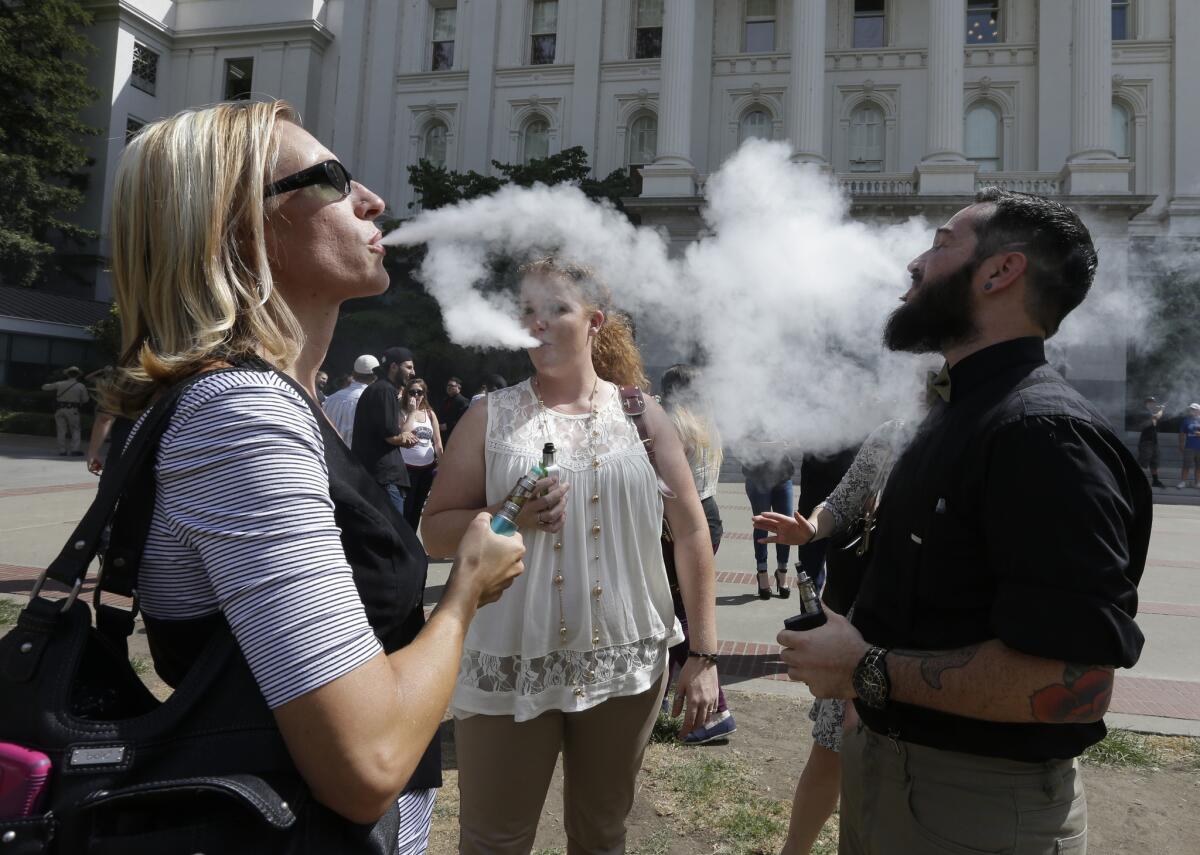Opinion: California is targeting vaping. Why aren’t youth alcohol and cigarette use also in the crosshairs?

Amid growing reports linking serious lung illnesses to vaping, California health officials issued a pointed warning Tuesday: Stop vaping immediately. Almost two weeks earlier, the Trump administration announced plans to remove all flavored electronic cigarettes — favored by youth — from the market.
At least 530 cases of vaping-associated respiratory illnesses have been reported. Nine of these cases
have been fatal, two of them in California.
This dramatic response to the problem of youth vaping stands in stark contrast to the way lawmakers and agencies have handled other similar — and as of now — more deadly health issues.
One-third of high school seniors consume alcohol and half of them are drinking flavored alcoholic beverages. Alcohol is responsible for more than 4,300 deaths among underage youth each year; yet federal policymakers have not banned the sale of all flavored alcoholic beverages.
More than 3,600 people die every day from smoking-related diseases. Close to half of these smokers used menthol-flavored cigarettes. But neither President Trump nor any lawmakers have called for a ban on flavored traditional cigarettes. In fact, e-cigarette bans — like those recently enacted in Michigan, New York and Massachusetts — would leave traditional cigarettes, including menthol brands, on the shelves.
Gun violence results in 100 deaths a day, but so far the U.S. Senate has not appeared to be willing to vote on simple measures that could reduce death rates.
So what might explain such different governmental responses to public health problems? And why the disproportionate reaction to vaping, which causes less disease and death than drinking, smoking and gun violence?
The history of public health sheds some insight. In 1850, Lemuel Shattuck and John H. Griscom, founders of the American public health movement, warned about the need for government to prevent outbreaks of infectious disease. However, it took 16 years for the first permanent local department of health to be established in New York City. Why? Disease had once been viewed as a personal problem that affected the poor and morally flawed; however, the spread of infections to the upper classes changed the government’s attitude and led to the implementation of public health reforms.
The situation is not much different today. Too often health problems that affect poor communities, especially people of color, do not generate the outrage and response until they begin to creep into more affluent, white communities.
This is perhaps best illustrated by government’s response to the crack epidemic of the 1980s. Crack cocaine was less expensive than powder cocaine and became widespread in black communities. But under the 1986 Anti-Drug Abuse Act, the federal government authorized starkly different criminal charges for crack cocaine users who were largely black and powder cocaine users who were largely white. The law established mandatory sentencing and a sentencing disparity — the distribution of 5 grams of crack yielded the same five-year prison sentence as the distribution of 500 grams of powder cocaine.
Today the racial and class disparity in response to public health problems persists with the opioid epidemic. As a recent article in the journal Epidemiology reveals, the opioid problem is not new. It has been around since at least 1979. However, the federal government did not declare opioid abuse to be a crisis until 2017. So what changed?
There has been an increase in the rate of opioid-related deaths, but it’s not as simple as that. Forty years ago, the rate of opioid-related deaths was higher among black people; today the opioid-related death rate among white people is twice that of black people. As a result, the epidemic came to be perceived as a white problem, attracting a huge amount of attention and resources.
The government’s reaction to youth vaping appears to be following suit. The recent deaths from vaping products, most of which have been tied to THC — the psychoactive compound in marijuana — are worrisome.
Still, the government’s response could be regarded as disproportionate to the problem as there is currently no evidence these illnesses are the result of legal e-cigarettes. While smoking is associated with lower levels of income and education, youth e-cigarette use is highest among teens from more affluent families.
What’s more, since smoking has largely been eliminated from public places and the workplace, too often we erroneously think of it as a problem that has been “solved,” making it easy for policymakers to overlook, despite the fact that it persists in poorer communities.
The administration and the FDA need to rethink their response to youth vaping and ask whether their reaction is proportionate to the scope of the problem. Youth are not only using flavored e-cigarettes, they also smoke flavored (menthol) cigarettes and drink flavored alcoholic beverages. How can policymakers justify enacting a complete ban on flavored tobacco products used in e-cigarettes while not moving against the other flavored vices?
Health officials, lawmakers and the public all need a balanced perspective on e-cigarettes. It’s not a winner-take-all-situation in which we have to choose between a ban on vaping or unfettered use. But government officials ought to consider how their efforts to protect one group may come at the expense of others.
Michael Siegel is a physician and professor in the Department of Community Health Sciences at the Boston University School of Public Health. He has been a tobacco researcher and anti-tobacco advocate for 30 years.
More to Read
A cure for the common opinion
Get thought-provoking perspectives with our weekly newsletter.
You may occasionally receive promotional content from the Los Angeles Times.










